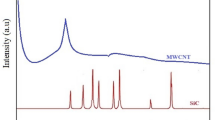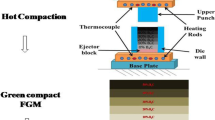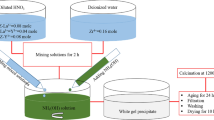Abstract
Despite its unique high efficiency and good environmental compatibility, the water-soluble binder system still encounters problems achieving a desired sintered part via ceramic injection molding because of the poor compatibility and the powder-binder segregation between ceramic powders and binders. The objective of this study was to obtain a sintered part with excellent properties by introducing a small quantity of oleic acid to the surface of zirconia powders before the mixing process. As opposed to many previous investigations that focused only on the rheological behavior and modification mechanism, the sintering behavior and densification process were systematically investigated in this study. With the modified powders, debound parts with a more homogeneous and smaller pore size distribution were fabricated. Also, a higher density and greater flexural strength were achieved in the sintered parts fabricated using the modified powders.
Similar content being viewed by others
References
V. Piotter, M. Beck, K. Plewa, H.J. Ritzhaupt-Kleissl, A. Ruh, and J. Hausselt, Micro PIM moves into the zone of industrial possibility, Met. Powder Rep., 64 (2009), No. 9, p. 35.
B.C. Mutsuddy, Injection molding, [in] Engineered Materials Handbook Volume 4: Ceramics and Glasses, Edited by D.W. Richerson, ASM International, Ann Arbor, 1991, p. 173.
D.M. Liu and W.J. Tseng, Yield behavior of zirconia-wax suspensions, Mater. Sci. Eng. A, 254(1998), No. 1-2, p. 136.
W. Liu, Z.P. Xie, T.Z. Bo, and X.F. Yang, Injection molding of surface modified powders with high solid loading: a case for fabrication of translucent alumina ceramics, J. Eur. Ceram. Soc., 31(2011), No. 9, p. 1611.
X.F. Yang, J.H. Yang, X.W. Xu, Q.C. Liu, Z.P. Xie, and W. Liu, Injection molding of ultra-fine Si3N4 powder for gas-pressure sintering, Int. J. Miner. Metall. Mater., 22(2015), No. 6, p. 654.
J.X. Wen, Z.P. Xie, and W.B. Cao, Novel fabrication of more homogeneous water-soluble binder system feedstock by surface modification of oleic acid, Ceram. Int., 42(2016), No. 14, p. 15530.
J.C. Liu, J.H. Jean, and C.C. Li, Dispersion of nano-sized γ-alumina powder in non-polar solvents, J. Am. Ceram. Soc., 89(2006), No. 3, p. 882.
D.M. Liu, Effect of dispersants on the rheological behavior of zirconia-wax suspensions, J. Am. Ceram. Soc., 82(1999), No. 5, p. 1162.
P.J. Thistlethwaite, M.L. Gee, and D. Wilson, Diffuse reflectance infrared Fourier transform spectroscopic studies of the adsorption of oleate/oleic acid onto zirconia, Langmuir, 12(1996), No. 26, p. 6487.
J.Y. Jeng, J.C. Liu, and J.H. Jean, Dispersion of oleate-modified CuO nanoparticles in a nonpolar solvent, J. Am. Ceram. Soc., 90(2007), No. 11, p. 3676.
W.W. Yang and M.H. Hon, In situ evaluation of dimensional variations during water extraction from alumina injection-molded parts, J. Eur. Ceram. Soc., 20(2000), No. 7, p. 851.
C.F. Escobar and L.A. dos Santos, New eco-friendly binder based on natural rubber for ceramic injection molding process, J. Eur. Ceram. Soc., 35(2015), No. 13, p. 3567.
V.A. Krauss, A.A.M. Oliveira, A.N. Klein, H.A. Al-Qureshi, and M.C. Fredel, A model for PEG removal from alumina injection molded parts by solvent debinding, J. Mater. Process. Technol., 182(2006), No. 1-3, p. 268.
W.J. Tseng, D.M. Liu, and C.K. Hsu, Influence of stearic acid on suspension structure and green microstructure of injection-molded zirconia ceramics, Ceram. Int., 25(1999), No. 2, p. 191.
X.F. Yang, W. Liu, Z.P. Xie, and X.W. Xu, Optimization of the compositions of PEG/PMMA binder system in ceramic injection moulding via water-debinding, Appl. Mech. Mater., 302(2013), p. 556.
X.F. Yang, C. Jia, Z.P. Xie, W. Liu, and Q.C. Liu, Water- soluble binder system based on poly-methyl methacrylate and poly-ethylene glycol for injection molding of large-sized ceramic parts, Int. J. Appl. Ceram. Technol., 10(2013), No. 2, p. 339.
W. Liu, Z.P. Xie, and C. Jia, Surface modification of ceramic powders by titanate coupling agent for injection molding using partially water soluble binder system, J. Eur. Ceram. Soc., 32 (2012), No. 5, p. 1001.
S.H. Wu, Calculation of interfacial tension in polymer systems, J. Polym. Sci. Polym. Symp., 34 (1971), No. 1, p. 19.
S.H. Wu, Surface and interfacial tensions of polymer melts: II. Poly(methyl methacrylate), poly(n-butyl methacrylate), and polystyrene, J. Phys. Chem., 74(1970), p. 632.
S.Y. Lee and M.T. Harris, Surface modification of magnetic nanoparticles capped by oleic acids: characterization and colloidal stability in polar solvents, J. Colloid Interface Sci., 293(2006), No. 2, p. 401.
W. Liu, Z.P. Xie, X.F. Yang, Y. Wu, C. Jia, T.Z. Bo, and L.L. Wang. Surface modification mechanism of stearic acid to zirconia powders induced by ball milling for water-based injection molding, J. Am. Ceram. Soc., 94(2011), No. 5, p. 1327.
C.J. Tsai, C.N. Chen, and W.J. Tseng, Rheology, structure, and sintering of zirconia suspensions with pyrogallol-poly(ethylene glycol) as polymeric surfactant, J. Eur. Ceram. Soc., 33(2013), No. 15-16, p. 3177.
M.J. Mayo, Processing of nanocrystalline ceramics from ultrafine particles, Int. Mater. Rev., 41(1996), No. 3, p. 85.
Acknowledgements
This work was financially supported by the National Natural Science Foundation of China (Nos. 51572035 and 51502041).
Author information
Authors and Affiliations
Corresponding author
Rights and permissions
About this article
Cite this article
Wen, Jx., Zhu, Tb., Xie, Zp. et al. A strategy to obtain a high-density and high-strength zirconia ceramic via ceramic injection molding by the modification of oleic acid. Int J Miner Metall Mater 24, 718–725 (2017). https://doi.org/10.1007/s12613-017-1455-9
Received:
Revised:
Accepted:
Published:
Issue Date:
DOI: https://doi.org/10.1007/s12613-017-1455-9




